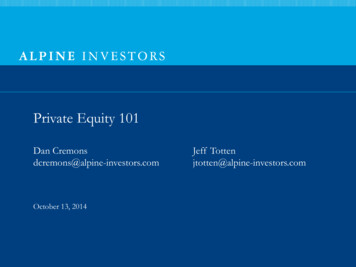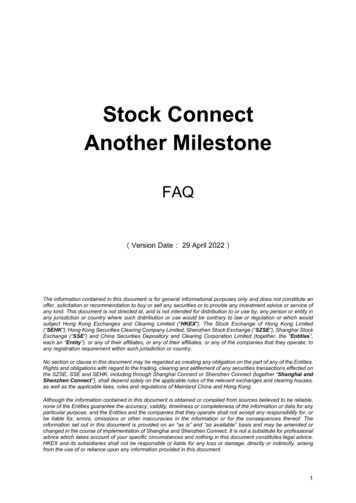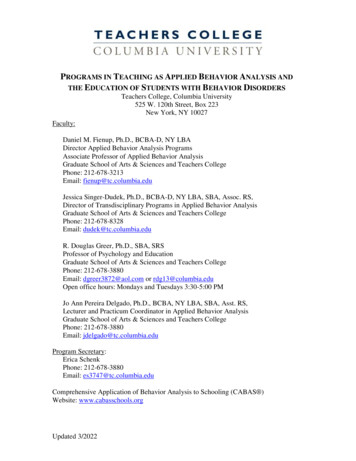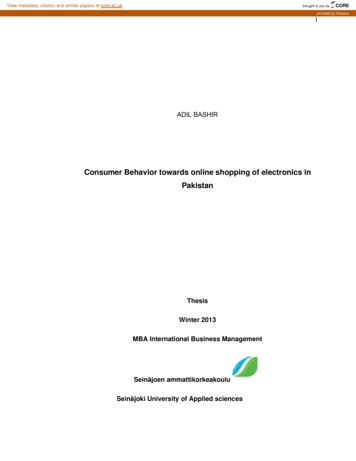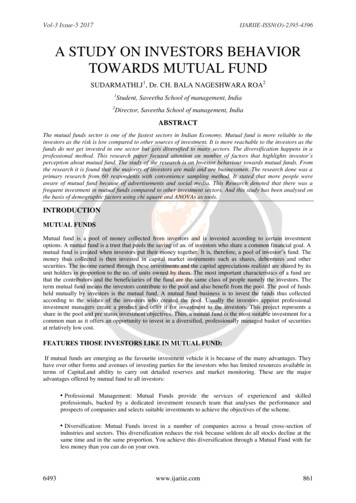
Transcription
Vol-3 Issue-5 2017IJARIIE-ISSN(O)-2395-4396A STUDY ON INVESTORS BEHAVIORTOWARDS MUTUAL FUNDSUDARMATHI.J1, Dr. CH. BALA NAGESHWARA ROA212Student, Saveetha School of management, IndiaDirector, Saveetha School of management, IndiaABSTRACTThe mutual funds sector is one of the fastest sectors in Indian Economy. Mutual fund is more reliable to theinvestors as the risk is low compared to other sources of investment. It is more reachable to the investors as thefunds do not get invested in one sector but gets diversified to many sectors. The diversification happens in aprofessional method. This research paper focused attention on number of factors that highlights investor’sperception about mutual fund. The study of the research is on Investor behaviour towards mutual funds. Fromthe research it is found that the majority of investors are male and are businessmen. The research done was aprimary research from 60 respondents with convenience sampling method. It stated that more people wereaware of mutual fund because of advertisements and social media. This Research denoted that there was afrequent investment in mutual funds compared to other investment sectors. And this study has been analysed onthe basis of demographic factors using chi square and ANOVAs as tools.INTRODUCTIONMUTUAL FUNDSMutual fund is a pool of money collected from investors and is invested according to certain investmentoptions. A mutual fund is a trust that pools the saving of an. of investors who share a common financial goal. Amutual fund is created when investors put their money together. It is, therefore, a pool of investor’s fund. Themoney thus collected is then invested in capital market instruments such as shares, debentures and othersecurities. The income earned through these investments and the capital appreciations realized are shared by itsunit holders in proportion to the no. of units owned by them. The most important characteristics of a fund arethat the contributors and the beneficiaries of the fund are the same class of people namely the investors. Theterm mutual fund means the investors contribute to the pool and also benefit from the pool. The pool of fundsheld mutually by investors is the mutual fund. A mutual fund business is to invest the funds thus collectedaccording to the wishes of the investors who created the pool. Usually the investors appoint professionalinvestment managers create a product and offer it for investment to the investors. This project represents ashare in the pool and pre status investment objectives. Thus, a mutual fund is the most suitable investment for acommon man as it offers an opportunity to invest in a diversified, professionally managed basket of securitiesat relatively low cost.FEATURES THOSE INVESTORS LIKE IN MUTUAL FUND:If mutual funds are emerging as the favourite investment vehicle it is because of the many advantages. Theyhave over other forms and avenues of investing parties for the investors who has limited resources available interms of CapitaLand ability to carry out detailed reserves and market monitoring. These are the majoradvantages offered by mutual fund to all investors: Professional Management: Mutual Funds provide the services of experienced and skilledprofessionals, backed by a dedicated investment research team that analyses the performance andprospects of companies and selects suitable investments to achieve the objectives of the scheme. Diversification: Mutual Funds invest in a number of companies across a broad cross-section ofindustries and sectors. This diversification reduces the risk because seldom do all stocks decline at thesame time and in the same proportion. You achieve this diversification through a Mutual Fund with farless money than you can do on your own.6493www.ijariie.com861
Vol-3 Issue-5 2017IJARIIE-ISSN(O)-2395-4396 Convenient Administration: Investing in a Mutual Fund reduces paperwork and helps you avoid manyproblems such as bad deliveries, delayed payments and follow up with brokers and companies. MutualFunds save your time and make investing easy and convenient. Return Potential: Over a medium to long-term, Mutual Funds have the potential to provide a higherreturn as they invest in a diversified basket of selected securities. Low Costs: Mutual Funds are a relatively less expensive way to invest compared to directly investingin the capital markets because the benefits of scale in brokerage, custodial and other fees translate intolower costs for investors. Liquidity: In open-end schemes, the investor gets the money back promptly at net asset value relatedprices from the Mutual Fund. In closed-end schemes, the units can be sold on a stock exchange at theprevailing market price or the investor can avail of the facility of direct repurchase at NAV relatedprices by the Mutual Fund Transparency: You get regular information on the value of your investment in addition to disclosureon the specific investments made by your scheme, the proportion invested in each class of assets and thefund managers investment strategy and outlook Flexibility: Through features such as regular investment plans, regular withdrawal plans and dividendreinvestment plans, you can systematically invest or withdraw funds according to your needs andconvenience. Affordability: Investors individually may lack sufficient funds to invest in high-grade stocks. A mutualfund because of its large corpus allows even a small investor to take the benefit of its investmentstrategy. Well Regulated: All Mutual Funds are registered with SEBI and they function within the provisions ofstrict regulations designed to protect the interests of investors. The operations of Mutual Funds areregularly monitored by SEBI.NEED FOR STUDY To find the main preference of the investorsTo find which investment has a much higher risk rateTo find which investment gives more return than othersTo find the safe investmentOBJECIVEThe main objective of this study is:1. To know various factors considered by the customers while going to invest in the mutual fund.2. To study the working of mutual fund3. To know Investment preferences and knowledge level of investors4. To know the personal and social status of investorsSCOPE1. The project will provide us the better platform to understand the history, growth and various aspectsof mutual fund.6493www.ijariie.com862
Vol-3 Issue-5 2017IJARIIE-ISSN(O)-2395-43962. It will also help to understand the behaviour of Indian investment towards mutual fund.3. It will also help to understand the importance of mutual fundLIMITATIONS1. This project is limited in scope as the survey is conducted with a shortage of time constraint and alsobased on secondary data.2. Due to ignorance factor some of the respondents were not able to give correct answer3. The respondent were not disclosing their exact portfolio because they have a fear in their mind thatthey can come under tax slab.REVIEW OF LITERATUREZhen, L. (1999) found the evidence of funds that receive more money subsequently performsignificantly better than those that lose money. This effect is short-lived and is largely but notcompletely explained by a strategy of betting on winners. In the aggregate, there was no significantevidence that funds receive more money subsequently beat the market. However, it states possible toearn positive abnormal returns by using the cash flow information for small funds and Fant, L. F.(1999) studied the relationship of stock market returns with components of aggregate equity mutualfund flows (new sales, redemptions, exchanges-in, and exchanges-out) was examined. The objectiveof the study was to find the investor’s behavior of mutual fund. The evidence suggests that the variouscomponents reflect different investor objectives and information.Grinblatt, M., & Keloharju, M. (2000) analyses the extent to which past returns determine thepropensity to buy and sell. It also analyses whether these differences in past-return-based behaviourand differences in investor sophistication drive the performance of various investor types. The mainobjective of the study was to find out the investment behaviour and performance of various investors.Kamesaka, A., Nofsinger, J. R., & Kawakita, H. (2003) noted the investment patterns andperformance of foreign investors, individual investors, and five types of institutional investors. Thiswas a particularly new and interesting finding that evidence of both information-based trading andbehavioural-based trading occurs in the same market. And Wang, C. (2003) analysed a unique data setand uncover a remarkable result that casts a new light on the home bias phenomenon. This Studysuggest that information asymmetries play an important role in equity home bias and that the benefitsof international risk sharing are limited to select firms. And Lin, A. Y., & Swanson, P. E. (2003)investigates trading behaviour and investment performance of foreign investors in 60 large-size firmslisted on the Taiwan Stock Exchange Findings show that foreign investors are short-term superiorperformers but long-term inferior performers. The short-term superior performance appears to bedriven partially by price momentum of winner’s portfolios rather than by risk taking. After controllingfor firm size, share turnover, and industry, foreigners' short-term performance in large-size, highturnover, and high-tech stocks is better than it is in small-size, low turnover, and non-high-tech stocks.Indro, D. C. (2004) examines the relationship between net aggregate equity fund flow and investorsentiment using weekly flow data. The study resulted net aggregate equity fund flow in the currentweek is higher when individual investors became more bullish in the previous and current weeks. Therelationship between net aggregate equity fund flow and investor sentiment remains strong even afteraccounting for the effects of risk premium and inflation. Overall, the evidence suggests that thebehaviour of equity fund investors is influenced not only by economic fundamentals, but also byinvestor sentiment.6493www.ijariie.com863
Vol-3 Issue-5 2017IJARIIE-ISSN(O)-2395-4396Massa, M., & Simonov, A. (2005) examined the way investors react to prior gains/losses. Inspect theinvestor reactions to different definitions of gains and losses and consider how gains and losses in onecategory of wealth affect holdings in other categories. We show that investors change their holdingsof risky assets as a function of both financial and real estate gains. Prior gains increase risk-taking,while prior losses reduce it. To interpret our results, we consider and compare three alternativehypotheses of investor behaviour: prospect theory, house money effect and standard utility theorywith diminishing risk dislike. Our evidence fails to support loss aversion, pointing in the direction ofthe house money effect or standard utility theory. Investors consider wealth in its entirety, and risktaking in financial markets is affected by gains/losses in overall wealth, financial wealth, and realestate wealth.Ranganathan, K. (2006) examined the related aspects of the fund selection behaviour of individualinvestors towards Mutual funds, in the city of Mumbai. This study will help developing andexpanding knowledge in the field of Consumer behaviour from the marketing world and also thefinancial economics has brought together. And Griffin, J. M., Nardari, F., & Stulz, R. M. (2006)investigates the lively relation between market-wide trading activity and returns in markets. Manystock markets display a strong positive relation between turnover and past returns. These findingsstand up in the face of various controls for unpredictability, alternative definitions of turnover,differing sample periods, and are present at both the weekly and daily frequency. The relation is morestatistically and economically significant in countries with high levels of corruption, with short-salerestrictions, and in which market volatility is high.Kim, K. A., & Nofsinger, J. R. (2007) identified Japanese individual investors by contrasting theirbehavior during a long bull market (1984-1989) to a long bear market (1990-1999).the objective ofthe study is to test the individuals' attitudes and preferences toward stock risk, book to-marketvaluation, and past returns, are different between market conditions. The study identified somestriking differences in investing behavior between the bull and the bear market. These behaviours areassociated with poor investment performance. The findings are consistent with existing behaviouraltheories, but some of our findings are not. B. M., & Odean, T. (2011) describes impression of researchon the stock trading behaviour of every single investors. This research documents that individualinvestors (1) disappoint standard benchmarks (2) sell winning investments while holding losinginvestments (3) are heavily influenced by limited attention and past return performance in theirpurchase decisions, (4) engage in naïve reinforcement learning by repeating past behaviours thatmatched with pleasure while avoiding past behaviours that generated pain, and (5) tend to holdundiversified stock portfolios. These behaviours deleteriously affect the financial worthy of individualinvestors.RESERCH METHODOLOGY3.1. RESEARCH DESIGNResearch Design adopted is descriptive research because descriptive explains the study and aims atfinding the present scenario of the investors towards mutual fund3.2. SAMPLE SIZEQuestionnaires are collected from 60 respondents3.3. SAMPLING TECHNIQUEThe respondents were selected by using convenient sampling method from the investors.3.4. DATA COLLECTIONPrimary data6493www.ijariie.com864
Vol-3 Issue-5 2017IJARIIE-ISSN(O)-2395-4396It is the first hand information, which is being collected by the researcher, or assistant is calledprimary data. In this study, the primary data was collected through structured questionnaire.Questionnaire was employed to collect the primary data from 60 respondents in the organization.Secondary dataBesides the primary data, the secondary data was also collected for the study. Websites and bookswere referred for this purpose from the library to facilitate proper understating of the study.3.5 DATA ANALYSISThe data collected from the primary sources were arranged sequentially and tabulated in thesystematic order.TOOLS FOR ANALYSISThe collected data were classified tabulated and analysed with some of the statistical too Chi Square TestA chi-squared test, also written as s test, is any statistical hypothesis test wherein the samplingdistribution of the test statistic is a chi-squared distribution when the null hypothesis is true. Withoutother qualification, 'chi-squared test' often is used as short for Pearson's chi-squared test. In thestandard applications of the test, the observations are classified into mutually exclusive classes, andthere is some theory, or say null hypothesis, which gives the probability that any observation falls intothe corresponding class. The purpose of the test is to evaluate how likely it is between theobservations and the null hypothesis. Chi-squared tests are often constructed from a sum of squarederrors, or through the sample variance. A chi-squared test can be used to attempt rejection of the nullhypothesis that the data are independent.HypothesisNull hypothesis (H0): There is no significance difference between two groups on the dependentvariable.Alternative hypothesis (H1): There is a significance difference between two groups on the dependentvariableANOVA- ONE WAYIn statistics, one –way analysis of variance is a technique used to compare means of three or moresamples. This technique can be used only for numerical data. The ANOVA tests the null hypothesisthat samples in two or more groups are drawn from populations with the same mean values.The results of a one –way ANOVA can be considered reliable as long as the following assumptionsare met 6493Response variable residuals are normally distributed.Samples are independent.Variances of population are equal.Responses for a given group are independent and identically distributed normal randomvariables.www.ijariie.com865
Vol-3 Issue-5 2017IJARIIE-ISSN(O)-2395-4396DATA ANALYSIS AND INTERPRETATIONTable 1.Analysis of Demographic profile of the investorsS.NO1.DEMOGRAPHIC FACTORSNo. of Respondents Male FemalePERCENTAGE %10058.341.72.Age Group of Investors 20-30 30-40 40&above10058.321.7203.Education Qualification of the investors UG PG Ph.D.10031.738.3304.Occupation of the investors Business service student house wife10038.330256.75.Income level of the investors 300000 300001-500000 500001-1000000 e above table depicts the demographic factors where in there no much difference between the number of maleand female investor’s. Majority of investor’s belonging to 20-30 age groups. Among the respondents, peoplehaving post-graduation are more aware about mutual fund. The people who are doing business are showingmore interest to investing in mutual fund. The income of investors are found that 3lakh and more than 3lakh to5lakh.TABLE.1S.No123456493Factor affectingGovernment policies (contributions,Tax, reductions)affect investor behaviour in a positive wayEconomic stability is a key element effecting investmentdecision investorsinvestors attach importance to innovations in banking andfinancial servicesinvestors income levels effects the maturity date of theinvestments they makeinvestors consider their past investment experiences whiletaking investment 632.862866
Vol-3 Issue-5 2017IJARIIE-ISSN(O)-2395-4396InterpretationFrom the above table it shows the factors affecting the mutual fund .the research analysed that rankingbases. 1st rank is investors attach importance to innovations in banking and financial services.Followed by 2nd investors consider their past investment experiences while taking investmentdecisions and investors income levels effects the maturity date of the investments they make andEconomic stability is a key element effecting investment decision investors, and finally 5th rank isGovernment policies (contributions, Tax, reductions)affect investor behaviour in a positive wayChi squareAnalysis of profitable investment preferred by investorsNull hypothesis: There is no significant difference amongthe profitable investment preferred by the investors.Alternative hypothesis: There is a significant differenceamong the profitable investment preferred by the investors.Category of the profitable investorsprofitableObserved N Expected N ResidualFix deposits1715.02.0Mutual fundsEquitiesOthers Total35536015.015.015.020.0-10.0-12.0Test Statisticscategory ofNo of investorsthe 33.000 .000Sig.a. 0 cells (.0%) have expectedfrequencies less than 5. Theminimum expected cell frequencyis 15.0.INTERPRETATIONFrom the above table the significant value is less than 0.05. There is a significant difference amongthe profitable investment preferred by the investors.6493www.ijariie.com867
Vol-3 Issue-5 2017IJARIIE-ISSN(O)-2395-4396CHI SQUARE TWO WAYTable 4.7Null hypothesis: There is no significant different between expected return percentage and riskAlternative hypothesis: There is significant different between expected return percentage and riskCountRISK EXPECTED TOWARDS RETURNwhat do you expect when you Investno riskpercentage of returnyou are expectingnominal riskmoderate 20%46111424Above20 %TotalTotal421Chi-Square TestsValuePearson Chi-SquareLikelihood RatioLinear-by-LinearAssociationN of Valid Cases8.012a7.508.131dfAsymp. Sig. (2sided)9 .5339 .5841.71760a. 10 cells (62.5%) have expected count less than 5. Theminimum expected count is .10.InterpretationFrom the above table it shows that the significant value is greater than the 0.05. There is no significantdifferent between expected return percentage and risk.ANOVA ONE WAYAnalysis of occupation towards the personal and social status6493www.ijariie.com868
Vol-3 Issue-5 2017IJARIIE-ISSN(O)-2395-4396Null hypothesis: There is no significant different between occupation towards personal and socialstatus.Alternative hypothesis: There is significant different between occupation towards personal and socialstatus.S.NOinvestors Personal and social statusf valueSignificant1Investors family structure.334.8012Investors behaviour4.900.0043Investors prefer1.636.1914Investment tools.255.8575Investment decision.486.6946Investors religious and politicalview.537.6597Investors making payment1.958.131InterpretationFrom the above table it shows that the significant value is greater than the 0.05. There is nosignificant different between occupation towards personal and social status.6493www.ijariie.com869
Vol-3 Issue-5 2017IJARIIE-ISSN(O)-2395-4396ANOVA ONE WAYAnalysis of occupation towards investor’s preference and knowledgeNull hypothesis: There is no significant different between occupation towards investor’s preference andknowledgeAlternative hypothesis: There is significant different between occupation towards investor’s preference andknowledgeTable 4.14s.noInvestmentknowledge1preferencesandf testsignificantInvestors investment tools.987.4062Investors bank preference0.74.9743Investors preference.923.4364Gold attention of investors.862.466InterpretationFrom the above table it shows that the significant value is greater than the 0.05. There is nosignificant different between occupation towards investor’s preference and knowledge.Analysis of Age towards investor’s preference and knowledgeNull hypothesis: There is no significant different between age towards investor’s preference andknowledgeAlternative hypothesis: There is significant different between age towards investor’s preference andknowledge6493www.ijariie.com870
Vol-3 Issue-5 2017IJARIIE-ISSN(O)-2395-4396Table 4.15S.NOInvestmentknowledge1preferencesandf testSignificantInvestors investment tools.007.9932Investors bank preference1.942.1533Investors preference1.432.2474Gold attention of investors.221.803InterpretationFrom the above table it shows that the significant value is greater than the 0.05. There is nosignificant different between age towards investor’s preference and knowledge.Suggestions It is found that majority of the investors are male. So, the company concentrate more awareness about mutual fund on females.The company can concentrate more on PG & Ph.D. Level because majority of the investors arefrom this level.The company should concentrate more on businessmen & private working investors.The middle level income level ( 300000) should be concentrated more because their highinvolvement in MF & High income group should be made aware of mutual fund plan as there islow involvement.The majority of the investors belongs to 20-30age group.There is a different opinion among the gender towards personal and social status.CONCLUSION.The most important characteristics of a mutual fund are that the contributors and the beneficiaries of the fundare the same class of people namely the investors. The term mutual fund means the investors contribute to thepool and also benefit from the pool. The pool ofFunds held mutually by investors are the mutual fund. A mutual fund business is to invest the funds thuscollected according to the wishes of the investors who created the pool. These studies primarily aim to find outthe various factors considered by the customers while going to invest in the mutual fund. This study describesthe strong relationship between demographic data in respect of different parameters. Investors and diversifiedinvesting in different investment option, mutual fund plan and investment period place are better to concentrate.6493www.ijariie.com871
Vol-3 Issue-5 2017IJARIIE-ISSN(O)-2395-4396Bibliography6493 Ranganathan, K. (2006). A Study of Fund Selection Behaviour of Individual Investors towardsMutual Funds-with Reference Mumbai city. Zhen L. (1999). Is money smart? A study of mutual fund investors' fund selection ability. TheJournal of Finance, 54(3), 901-933. Fant, L. F. (1999). Investment behavior of mutual fund shareholders: The evidence fromaggregate fund flows. Journal of Financial Markets, 2(4), 391-402. Grinblatt, M., & Keloharju, M. (2000). The investment behavior and performance of variousinvestor types: a study of Finland's unique data set. Journal of financial economics, 55(1), 4367. Griffin, J. M., Nardari, F., & Stulz, R. M. (2006). Do investors trade more when stocks haveperformed well? Evidence from 46 countries. The Review of Financial Studies, 20(3), 905-951. Grin blatt, M., Keloharju, M., & Linnainmaa, J. T. (2012). IQ, trading behaviour, andperformance. Journal of Financial Economics, 104(2), 339-362. Jackson, A. (2003). The aggregate behaviour of individual investors Kamesaka, A., Nofsinger, J. R., & Kawakita, H. (2003). Investment patterns and performanceof investor groups in Japan. Pacific-Basin Finance Journal, 11(1), 1-2 Wang, C. (2003). The behaviour and performance of major types of futures traders. Journal ofFutures Markets, 23(1), 1-31. Massa, M., & Simonov, A. (2005). Behavioural biases and investment. Review of Finance,9(4), 483-507. Kim, K. A., & Nofsinger, J. R. (2007). The behavior of Japanese individual investors duringbull and bear markets. The Journal of Behavioral Finance, 8(3), 138-153.www.ijariie.com872
Vol-3 Issue-5 2017 IJARIIE -ISSN(O) 2395 4396 6493 www.ijariie.com 862 Convenient Administration: Investing in a Mutual Fund reduces paperwork and helps you avoid many problems such as bad deliveries, delayed payments and follow up with brokers and companies.
